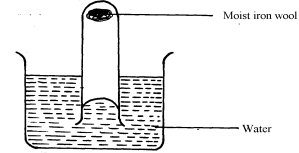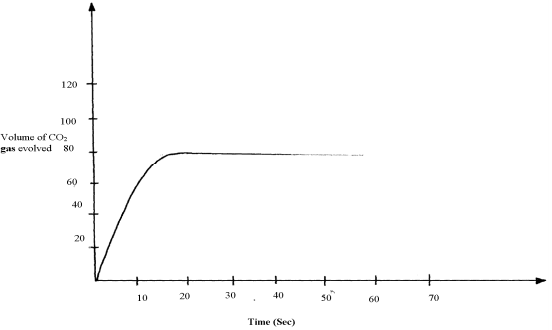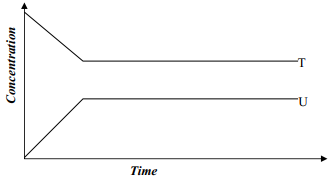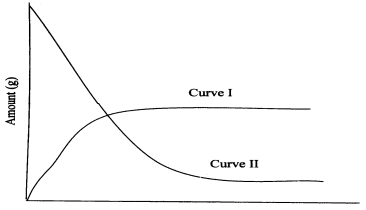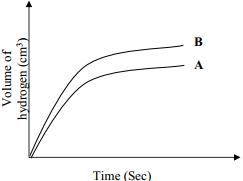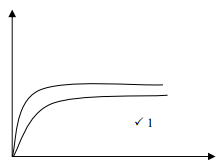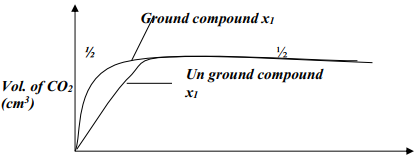Questions
- Study the following equilibrium reaction and answer the questions that follow:-

Given that in an acid solution, H3O+(aq) act in place of hydrogen ions, H+, according to the equation.
H3O+(aq) + OH-(aq) → 2H2O(l)
Explain what would be observed when potassium hydroxide solution is added to the above equilibrium mixture - The scheme below shows the energy changes that take place between ice, water and steam.
Study it and answer the questions that follow:- What name is given to the energy change ΔH4?
- What is the sign ΔH3, give a reason
- The table below gives bond energies for three covalent bonds
Bond Bond energy (KJmol-1) H –H
Cl – Cl
H – Cl435
240
430- Calculate the energy change for the following reaction:
H2(g) + Cl2(g) → 2HCl(g) - Sketch an energy level diagram for the reaction in (a) above
- Calculate the energy change for the following reaction:
- The sketch below was obtained when 2g of magnesium was reacted with excess of 2M hydrochloric acid. The volume of hydrogen evolved was then plotted against time as shown below:
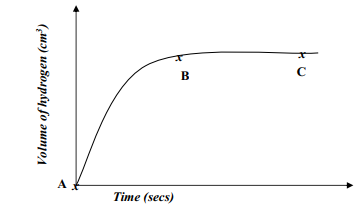
- On the same axis plot the graph that would be obtained if 1M hydrochloric acid was used instead of 2M hydrochloric acid. Explain
- Explain the significance of the flat portion BC of the curve
- In a closed system an equilibrium exists between Nitrogen (IV) Oxide and dinitrogen tetraoxide as shown in the equation below:
N2O4 (g) ⇌ 2NO2 (g); ΔH = + 27.5KJ
Pale yellow Reddish brown- State and explain the observation when a glass syringe containing the equilibrium mixture is immersed in ice-cold water
- If the piston of the syringe is pushed, state the effect on the position of the equilibrium
- The table below gives the volumes of the gas produced when different volumes of 2M hydrochloric acid were reacted with 1.0g of a lump of an alloy of Magnessium and copper at room temperature
Volume of 2M hydrochloric acid (cm3) Volume of gas (cm3) 0
10
20
30
40
500
240
480
600
600
600- Write an equation for the reaction that occurred
- On the grid provided below, plot a graph of the volume of the gas produced (vertical axis) against the volume of acid added (Note that before the reaction comes to completion, the volume of the gas produced is directly proportional to the volume of the acid added)
- From the graph, determine:
- The volume of the gas produced if 13.0cm3 of 2M hydrochloric acid had been used
- The volume of 2M hydrochloric acid required for the reaction to go to completion
- State and explain the effect on the rate of production of the gas if:
- 1.0g of the lump of the alloy were replaced by 1.0g powder of the alloy
- The reaction was carried out at 35oC.
- In a series of experiments in which magnesium ribbon of uniform width reacted with 2.0M Hydrochloric acid, the rates of evolution of hydrogen gas were found to be as follows:-
Length of ribbon (cm) 1.0 2.0 3.0 4.0 5.0 6.0 7.0 Rate of Evolution of hydrogen (cm3/min) 1.1 1.8 2.7 3.6 4.6 5.4 6 -
- Draw a graph of rate of evolution of hydrogen gas against length of ribbon
- What conclusion can you make from this graph? *
- Determine the rate of evolution of hydrogen gas from a piece of magnesium ribbon 12cm long under the same conditions *
- With dotted line, sketch on the same axis the graph that would be obtained if all the ribbons were ground into powder *
- The curves below represent the changes in concentration of substances E and F with time in reaction
E(g) ⇌ F(g)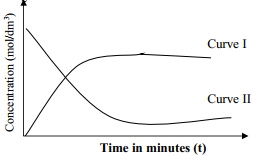
- Which curve represents the change in the concentration of substance F? Give a reason
- Give one reason for the shapes of the curves after two minutes
-
- A typical electrolysis cell uses a current of 40,000 amperes. Calculate the mass (in Kg of aluminium produced in one hour). (Al = 27) (Faraday = 96500 Coloumbs )
- The table below shows the volumes of nitrogen (IV) oxide gas produced when different volumes of 1M nitric acid were each reacted with 0.635g of copper at room temperature.
- Give a reason why hydrochloric acid can not be used instead of nitric acid
- Explain how the rate of the reaction between copper and nitric acid would be affected if the temperature of the reaction mixture was raised
- On the grid provided below, plot a graph of the volume of the gas produced (vertical axis) against volume of acid
- Using the graph, determine the volume of:
- Nitrogen (IV) oxide produced when 30cm3 of 1M nitric acid were reacted with 0.635g of copper
- 1M nitric acid which would react completely with 0.635g of copper
- The graph below represents the volume of gas collected against time when dilute sulphuric acid is reacted with Zinc granules:-
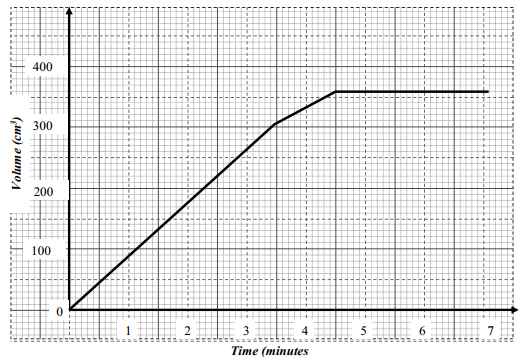
- Determine the rate of reaction between the 1st and 3rd minute
- When did the reaction stop?
- Give a possible reason for the reaction to stop
- The equation below represents a reaction that takes place in an industrial process
4NH3(g) + 5O2(g) → 6H2O(g) + 4NO(g)- Name the catalyst used
- What are the other conditions for the reaction?
- Why are the products cooled before being oxidised?
- Nitrogen reacts with hydrogen according to the equation below:-
N2(g) + 3H2(g) ⇌ 2NH3(g) ΔH = -92KJ- How would the yield of ammonia be affected by increase in :-
- Pressure
- temperature
- The ammonia produced is isolated form the other gases from time to time. How does this affect the equilibrium?
- How would the yield of ammonia be affected by increase in :-
- Explain how you would obtain an insoluble salt XSO4 when you are provided with the following:-
- Distilled water
- Solid YSO4 which is soluble in water
- Solid salt X(NO3)2
- Metal R and S were used to form a cell. The following half equations show the standard electrode potentials of the half cells. (R and S are not actual symbols of the element)
R2+(aq) + 2e- ⇌ R(s) Eθ = - 2.04V
S2+(aq) + 2e- ⇌ S(s) Eθ = - 0.47V
Write the full equation for the cell and calculate the e.m.f - The apparatus below were used to study the properties of air
- State two observations made at the end of the experiment
- Give one simple method that can be used to prevent rusting
- Equal volumes of 1M monobasic acids K and L were each reacted with excess zinc granules.
The table below shows the volumes of the gas produced after two minutes
Acid Volume of gas (cm3) K 40 L 100 - Explain the difference in the volumes of the gas produced
- How can the production of the gas be increased?
- The following is a thermochemical equation for the reaction between hydrogen and oxygen
H2(g) + O2(g) → H2O(l) ΔH = -287kJmol-1
Calculate the bond energy between the elements in water given that:
O = O = +496kJmol-1 H-H = + 435kJmol-1 - AgClO2(s) ⇌ Ag(s) + ½Cl2(g) + O2(g) ΔH = 0.00KJ/mol
What is the effect on the position of equilibrium of the above system if temperature is decreased? Give a reason - Sodium carbonate was reacted with dilute sulphuric (VI) acid at 25oC. The volume of carbon (IV) Oxide gas liberated was recorded at 10seconds interval. Below is a graph of the volume of carbon (IV) Oxide gas evolved against time.
On the same axes, sketch the curve labelled V that would be obtained if Barium carbonate was used instead of sodium carbonate. (All conditions remain constant) -
- What is meant by activation energy?
- A certain mass of unground compound X1 reacted with excess dilute hydrochloric acid.
The volume of carbon (IV) oxide gas liberated was measured after every 20 seconds.
The results were presented as shown in the graph below:-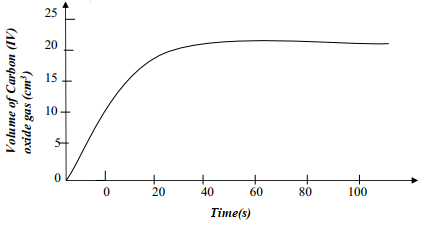
- On the same axis, sketch the curve that would be obtained if the experiment was repeated using ground compound X1
- Explain the shape of your curve in (b) (i) above
- The sketch below shows the rate at which substance T is converted into U. Study it and answer the questions that follows:-
When the equilibrium has been established the two curves become horizontal after sometime.
Explain the effect of the amount of the two reactants and products - Elements A, B, C, and D are not actual symbols, have atomic numbers 19, 9, 12 and 10 respectively.
- Which two elements represent non-metals
- Write the formula of the compound formed between elements B and C and identity the bond present in the compound
- An equilibrium is established between nitrogen tetra -oxide and nitrogen (IV) oxide as shown below: State and explain what happens when temperature is increased
N2O4(l) ⇌ 2NO2(g)
Pale yellow Red-brown fumes - The graph below shows the amount of calcium carbonate and calcium chloride varying with time in the reactions:
CaCO3 (s) + 2HCI (aq) → CaCl2(aq) + H2O (g) + CO2 (g)- Which curve shows the amount of calcium chloride varying with time? (lmk)
- Explain why the two curves become horizontal after a given period of time. (lmk)
- Sketch on the graph how curve II would appear if the experiment was repeated using a more dilute hydrochloric acid solution (lmk)
- An equilibrium is established between CrO4 and H+ ions as shown below:
2CrO4(aq) + 2H+(aq) ⇌ Cr2O7(aq) + H2O(l)
(Yellow) (Orange)
State the effect on the equilibrium when;- Pressure is increased
- Oxygen gas is added
- State and explain and explain the observation made when aqueous sodium hydroxide is added to the equilibrium mixture
- Two experiments were carried out as follows and the volume of hydrogen gas evolved measured at intervals of 10seconds for 100seconds.
- 8cm of magnesium ribbon was added to 1M hydrochloric acid
- 8cm of magnesium ribbon was added to 0.5M hydrochloric acid
Graphs of volume of hydrogen evolved against time were plotted- Which of the graph was obtained for reaction (i) above? Explain
- Explain the general shape of the graph
- Bromine dissolves in water forming a brown solution, according to the dynamic equation below.
Br2(aq) + H2O(l) ⇌ 2H+(aq) + Br-(aq) + OBr-(aq)
State and explain the observation that could be made if a solution of sodium hydroxide is added to the system
Answers
- colour changes from red to blue
H3O+ ions and L-(aq) ions which form red solution. -
- ΔH4 – latent heat of fusion
- ΔH3 - is negative particles lose hat/process is exothermic/heat is given out (any )
-
- H-H(g) + Cl – Cl (g) → 2H – Cl
Bonds broken bonds formed
∣H-H = 435 KJ 2H – Cl = 430 x 2
∣Cl – Cl = 240 KJ. = 860 KJ.
Total = 675 KJ.
∆HR = 860 + 675 √½
= -185KJ √½ -
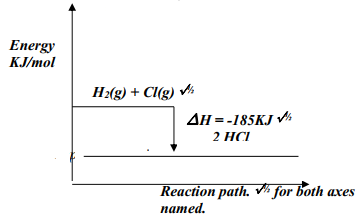
- H-H(g) + Cl – Cl (g) → 2H – Cl
-
-
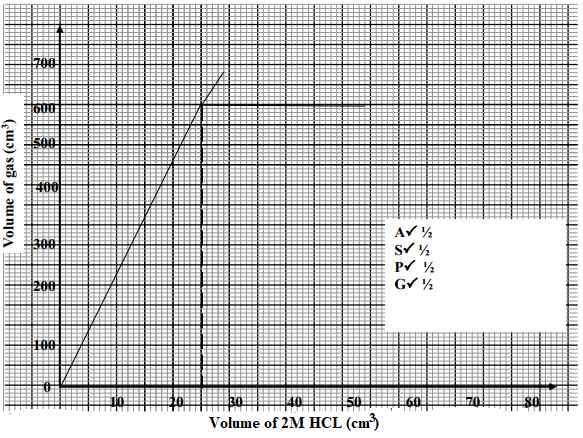
- Graph should be less steeper showing lower reaction rate since HCl is less concentrated. √½ - Graph flattens out at BC showing that all the magnesium has been used up, hence, no reaction is taking place √½ and there is therefore no evolution of hydrogen gas. √½ The volume of the gas, therefore, remains constant. √½
-
-
- Pale yellow liquid is observed. √1 Backward reaction is favoured since √½ it is exothermic.
Dinitrogen tetra oxide liquefies√½ at very low temperature to pale yellow liquid. - Pressure increase, and favours backward reaction √½ which is at lower pressure; hence equilibrium shifts to the right. √½
- Pale yellow liquid is observed. √1 Backward reaction is favoured since √½ it is exothermic.
-
- Mg(s) + 2 HCl(aq) → MgCl2(aq) + H2(g) √1
-
- Showing on the graph. √½ Answer √½
- Showing on the graph. √½ Answer √½
-
- The rate of reaction increases. √1
The surface area of particles has been increased √½ thus increasing the area √½ of contact of the reacting particles. - The rate of reaction increases. √1
Increase in temperature results in crease in the kinetic energy of the particles. This makes the particles move faster and collide more frequently with sufficient energy to cause more effective collision per given time. √1
- The rate of reaction increases. √1
-
-
- Drawn on graph paper A = ½ mk
S = ½ mk
P = 1 mk
C = 1 mk - Rate of evolution of hydrogen gas increases with increase in length of magnesium ribbon.
- Read from the student’s graph. 1 mk – showing on graph
1 mk – for answer. - Shown on the graph paper.
- Drawn on graph paper A = ½ mk
-
-
- Curve I Reason: F increases as E decreases.
- Equilibrium is achieved.
-
-
- Q = 40000 x 60 x 60 = 144000000c
Mass of Al = 144000000 x 27
3 x 96500
= 13.43kg -
- Hydrochloric acid is a weaker oxidizing agent which cannot oxidize copper to form Nitrogen (VI) Oxide gas
- It increases ✓ 1 mark
Molecules/ particles acquire the necessary activation energy// Kinetic energy. This increases the frequency of collisions hence the rate of reaction ✓ ½ mark - Graph
- Scale 1 mark with axis well labeled
- Plotting + all points correct 1 mark
- 5 correct points ½ mark
- Less than 5 points 0 mark
- Correct smooth curve 1 mark
TOTAL 3 marks -
- 360cm3 Read correct value from graph + .05
- 40cm3 = Value from graph + .05
Read where it levels off
-
- 260 – 85 = 175 = 87.5cm3/mn;
2 2 - 4½ min;
- Zinc was used up/H2SO4 used up;
- 260 – 85 = 175 = 87.5cm3/mn;
-
- Platinum / Platinum Rhodium
- Pressure -9atm ( ½ mk)
Temp – 700oC – 900oC ( ½ mk) - Reaction is exothermic
-
-
- Will increase;
- Decrease;
-
-
- Dissolve solid√ ½ YSO4 to obtain√ ½ YSO4 in solution,
- Dissolve √ ½ X(NO3)2 in water to obtain √ ½ X (NO3)2 solution.
- Mix the two above solutions
- Filter to obtain XSO4 solid residue, rinse with water and dry by heating√ ½ under asbestos pad.
- R(s) + S2+(aq) → R2+(aq) + S(s) √1 (1 mk)
E.m.f = 0.47 – (-2.04)
= -0.47 + 2.04
= 1.57V √1 (1 mk) -
- – Water level rises. √1 (1 mk)
Grey Iron wool changes to brown. √1 (1 mk) 3 (any one of these scores) - – Oiling and greasing. √1 (1 mk)
- Painting.
- – Water level rises. √1 (1 mk)
-
- L is more ionized √1 than K hence reacts faster √1 producing higher volume of a gas. Or L is a stronger acid therefore ionized faster than K a weaker acid
- Increasing the temeprature√1 using zinc powder/increasing the concentration of acid.
- Energy of reaction = Bond breakage + Bond formation. √1
Bond formation = Energy of reaction – Bond Breakage
= -287 – 931 √1 3
= - 1218 K Joules per mole. √1 (3 mks) - - No effect on the position of the equilibrium
- RXM is neither endothermic nor exothermic hence not affected by changes in temperature enthalpy is zero. -
-
- the minimum energy required by the reaction particles to cause a successful collision to form product
-
NB. Sketch curve should be to the left and both flatten not at the same final volume- curve is steep to the left due to the size of particles of ground compound x is reduced,√ ½ increasing surface area√ ½ of the particles thus increasing area of contact of
- At equilibrium there will be very little of T that has reacted.√1At equilibrium there will be a lot of T and very little V produced hence equilibrium lies to the left or forms the reactants√1
- - CB2
- Ionic bond - - Intensity of red-brown fumes increases.
- High temperature vapourizes liquid nitrogen tetra-oxide to form nitrogen (IV) oxide that is red-brown. -
- Curve 1
- After sometime, the rate of formation of CaCl2 or rate of depletion of CaCO3 become to low that cant be evaluated
-
- Equilibrium shifts o the left, more CO2 formed (Increase in pressure favors reaction producing fewer molecules)
- Equilibrium shifts to the left, more CO2(g) formed
- The solution turns yellow. Equilibrium shifts to the left when NaOH is added, the OH– ions react with H+ ions forcing more of cr2O72- and H2O to react forming more H+ and crO42- ions the reaction particles causing higher rate of reaction and twice shorter time√ ½
-
- B ; The acid had higher concentration (½mk)
- The rate of reaction is initially high (½mk) because of high concentration of the reactant but decreases ( ½mk) steadily as the concentration also decreases.
- Yellow/brown colour of bromine water ((½mk) fades or becomes colourless because sodium hydroxide solution provides OH- ions which reacts with H+ ions to form water (½mk) shifts the equilibrium to the right
Join our whatsapp group for latest updates
Tap Here to Download for 50/-
Get on WhatsApp for 50/-
Download Reaction Rates and Reversible Reactions Questions and Answers - Chemistry Form 4 Topical Revision.
Tap Here to Download for 50/-
Get on WhatsApp for 50/-
Why download?
- ✔ To read offline at any time.
- ✔ To Print at your convenience
- ✔ Share Easily with Friends / Students


